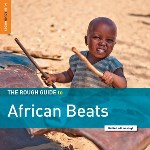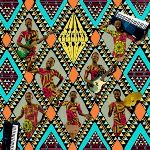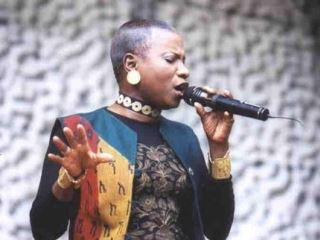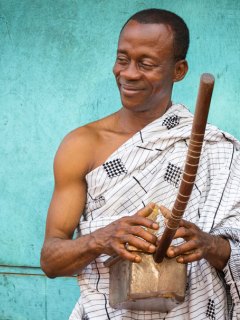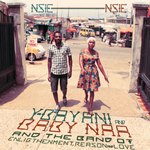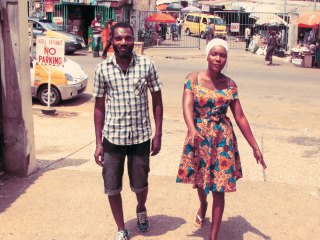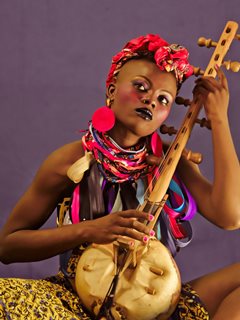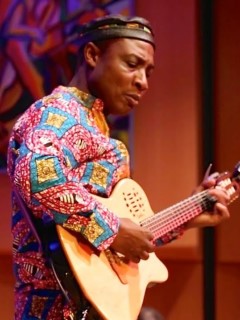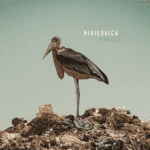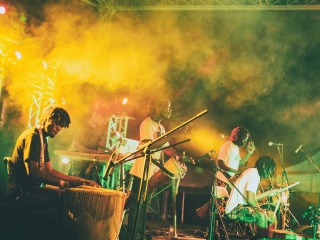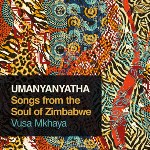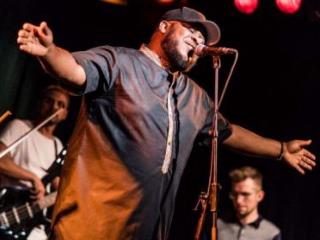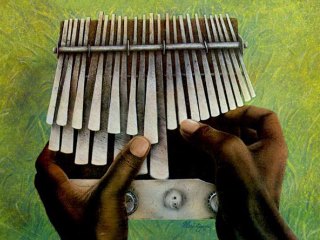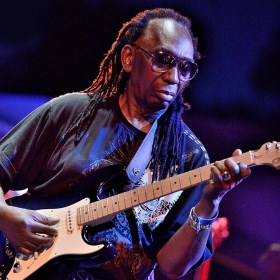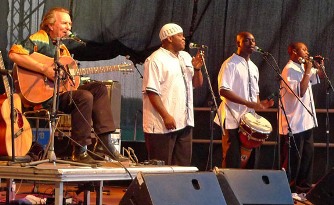FolkWorld #73 11/2020
Nowhere is the beat of a drum more symbolic of a culture than in Africa, where it’s forever been the heartbeat of daily life. From the trance percussion of South Sudan to the gnawagroove of Morocco, this is an exploration into a continent’s rhythmic life source.
Ft.
Wayo (Sudan),
Kenge Kenge (Kenya),
Simo Lagnawi (Morocco),
Sotho Sounds (Lesotho),
Mamane Barka (Niger),
Hope Masike (Zimbabwe),
Mamoutou Dembele (Mali),
Seprewa Kasa (Ghana).
"The Rough Guide to African Beats", World Music Network, 2020
Music of Africa
Music of Africa, Part 2: Benin, Ghana, Uganda, Zimbabwe.
Benin
The seven-member Star Feminine Band comes from the remote Atakora region in northwestern Benin, a group of young girls between the ages of nine
and fifteen who are cheeky, carefree, full of energy, with a good dose of self-confidence, a lot of charisma and a deep faith in the genre how garage rock,
pop and traditional songs mix up their homeland. The band was founded in 2016 as an idea of André Baleguemon, who wanted to put
together an exclusively female band that took on current issues: "They talk about female genital mutilation, abuse and violence against women.
We want to include these issues in the political debate in Benin and, if possible, elsewhere in Africa."
Star Feminine Band "Star Feminine Band", Born Bad Records, 2020
Benin has played an important role in the African music scene, producing one of the biggest stars to come out of the continent in Angélique Kidjo. Post-independence, the country was home to a vibrant and innovative music scene, where native folk music combined with Ghanaian highlife, French cabaret, American rock, funk and soul, and Congolese rumba. It also has a rich variety of ethnomusicological traditions.
National music
The national anthem of Benin, adopted upon independence in 1960, is "L'Aube Nouvelle" (The New Dawn) by Gilbert Jean Dagnon. The Gangbe brass band is an internationally prominent Beninese ensemble.
Traditional music
The majority of Benin’s 9.32 million people live in the south. The population includes about 42 ethnic groups overall. These include coastal populations of Yoruba in the southeast, who migrated from what is now Nigeria in the 12th century, the Fon in the south central area around Abomey, Mina, Xueda and Aja who came from what is now Togo.
Northern peoples include the Dendi in the north-central area, who came from what is now Mali in the 16th century, the Bariba and Fula people in the northeast and the Betammaribe and Somba in the Atacora Range.
Popular music
In 1972, the Kérékou government came to power and instituted curfews and other measures that inhibited musical expression. Kérékou encouraged indigenous folk music. Some musicians, like Tohon Stan, adapted folk styles for mainstream audiences at home and abroad, including tchinkoumé, a funeral music played using water percussion which was adapted into tchink-system music.
Sagbohan Danialou, a multi-instrumentalist from Porto Novo, is another very influential musician who transformed traditional Vodou religious rhythms such as kakagbo into popular music.
Ignacio Blazio Osho was perhaps the most influential musician of the post-independence period, alongside Pedro Gnonnas y sus Panchos, Les Volcans and Picoby Band d'Abomey. Pedro produced the song Feso Jaiye, which became a hit and was performed by many bands at the 2nd All-Africa Games in 1973.
Nel Oliver debuted in France in 1976, borrowing elements from all over Africa and the United States to create "Afro-akpala-funk".
The “Tout Puissant” Orchestre Poly-Rythmo are still a household name in Cotonou and one of Africa's most prolific groups with over 50 LPs, hundreds of 45s and CD re-issues of their work. They have toured both Europe and the United States; according to a concert review in the New York Times, the band "belongs on the very short list of the world's greatest funk bands."
Beninese guitarist Lionel Loueke is one of the most important young musicians in jazz, infusing African influences. Loueke currently lives in New York and is a member of Herbie Hancock's band.
Wilfrid Houwanou is a Beninese singer-songwriter who goes by the stage name “ROBBI” (formerly Robbi Slo).
Zeynab Ouloukèmi Habib, born in Abidjan in 1975, has given concerts around Africa and won a Kora Award for Best Female West African Artist in 2005. She released her first album Intori in 2001, a second album D'un endroit à l'autre in 2004, and a third album Olukèmi in 2011.
Gangbé Brass Band, from Cotonou continued the trajectory of transforming traditional Vodou music, combining it with jazz and brass band traditions. Gangbe has released four albums: Gangbe (1998), Togbe (2001), Whendo (2004) and Assiko (2008), and tours extensively in Europe and North America.
The last few decades of the 20th century saw numerous other developments, including the rise of reggae brought from Jamaica by Vaya Yaovi.
Benin is also home to zouk musicians such as Richard Flash, Martin Hode, and Miss Espoir.
Ghana
There are many styles of traditional and modern music of Ghana, due to Ghana's cosmopolitan geographic position on the African continent. The best known modern genre originating in Ghana is Highlife. For many years, Highlife was the preferred music genre until the introduction of Hiplife and many others.
Traditional music
"Cinematic Roots Reggae" from Ghana, as it has probably never been heard before! Y-Bayani and Baby Naa are the perfect team of two natural voices -
without affect or other frills. They are supported on their debut album Nsie Nsie by the grooving "Band of Enlightenment, Reason & Love".
The nine songs show their own interpretation of reggae, striking a balance between Afroretroism and Afrohyperfuturism.
Y-Bayani & Baby Naa And The Band of Enlightenment, Reason & Love "Nsie Nsie", Philophon, 2020
The traditional musicology of Ghana may be divided geographically between the open and vast savanna country of northern Ghana inhabited by Ghanaians of Gur and Mande speaking groups; and the fertile, forested southern coastal areas, inhabited by Ghanaians speaking Kwa languages such as Akan.
- The northern musical traditions belong to the wider Sahelian musical traditions. It features a mix of melodic composition on stringed instruments such as the kologo lute and the gonjey fiddle, wind instruments such as flutes and horns, and voice; with polyrhythms clapped or played on the talking drum, gourd drums or brekete bass drums. The tradition of gyil music (balafon) is also common, especially in northwestern Ghana around Wa and Lawra. Music in the northern styles is mostly set to a minor pentatonic or chromatic scale and melisma plays an important part in melodic and vocal styles. There is a long history of either griot or praise-singing traditions.
- The music of the coast is associated with social functions, and relies on complex polyrhythmic patterns played by drums and bells as well as harmonized song. Drums and dance are often linked, and the tradition of royal talking drums fontomfrom (distinct from the northern talking drum) means music is widely used for communication of both tangible and esoteric topics. The most well known of southern Ghanaian drum traditions is the kete and adowa drum and bell ensembles. Music can also be linked to traditional religions. An exception to this rule is the Akan tradition of singing with the Seperewa harp-lute which had its origins in the stringed harps of the north and west.
Gold Coast period
During the Gold Coast era lexie, the Gold Coast was a hotbed of musical syncretism. Rhythms especially from gombe and ashiko, guitar-styles such as mainline and osibisaba, European brass bands and sea shanties, were all combined into a melting pot that became high-life.
Mid-20th century and the invention of Ghanaian pop
Ghana became an independent nation in 1957. The music of Ghana often reflects a Caribbean influence, yet it still retains a flavour all its own. While pan-Ghanaian music had been developed for some time, the middle of the 20th century saw the development of distinctly Ghanaian pop music. High-life incorporated elements of swing, jazz, rock, ska and soukous. To a much lesser extent, Ghanaian musicians found success in the United States and, briefly, the United Kingdom with the surprise success of Osibisa's Afro-rock in the 1970s.
Guitar bands in the 1930s, 1940s, 1950s and 1960s
In the 1930s, Sam's Trio, led by Jacob Sam (Kwame Asare), was the most influential of the high-life guitar-bands. Their "Yaa Amponsah", three versions of which were recorded in 1928 for Zonophone, was a major hit that remains a popular staple of numerous high-life bands. The next major guitar-band leader was E. K. Nyame, who sang in Twi. Nyame also added the double bass and more elements of the Western hemisphere, including jazz and Cuban music on the recommendation of his producer and manager E. Newman-Adjiri. In the 1960s, dance high-life was more popular than guitar-band high-life; most of the guitar bands began using the electric guitar until a roots revival in the mid-1970s.
Dance highlife evolved during World War II, when American jazz and swing became popular with the arrival of servicemen from the United States and United Kingdom. After independence in 1957, the socialist government began encouraging folk music, but highlife remained popular and influences from Trinidadian music. E. T. Mensah was the most influential musician of this period, and his band The Tempos frequently accompanied the president. The original bandleader of The Tempos was Guy Warren, who was responsible for introducing Caribbean music to Ghana and, later, was known for a series of innovative fusions of African rhythms and American jazz. Ebo Taylor, King Bruce, Jerry Hansen (musician) and Stan Plange also led influential dance bands during the 1950s and 1960s. By the 1970s, however, pop music from Europe and the US dominated the Ghanaian scene until a mid-1970s roots revival.
1970s: Head revival
By the beginning of the 1970s, traditionally styled highlife had been overtaken by electric guitar bands and pop-dance music. Since 1966 and the fall of President Kwame Nkrumah, many Ghanaian musicians moved abroad, settling in the US, and UK. High-life bands arose like Sammy Kofi's (also known as Kofi Sammy). In 1971, the Soul to Soul music festival was held in Accra. Several legendary American musicians played, including Wilson Pickett, Ike and Tina Turner and Carlos Santana. With the exception of Mexican-American Santana, these American superstars were all black, and their presence in Accra was seen as legitimizing Ghanaian music. Though the concert is now mostly remembered for its role as a catalyst in the subsequent Ghanaian roots revival, it also led to increased popularity for American rock and soul. Inspired by the American musicians, new guitar bands arose in Ghana, including Nana Ampadu& the African Brothers, The City Boys and others. Musicians such as C. K. Mann, Daniel Amponsah and Eddie Donkor incorporated new elements, especially from Jamaican reggae. A group called Wulomei also arose in the 1970s, leading a cultural revival to encourage Ghanaian youths to support their own countryman's music. By the 1980s, the UK was experiencing a boom in African music as Ghanaian and others moved there in large numbers. The group Hi-Life International was probably the most influential band of the period, and others included Jon K, Dade Krama, Orchestra Jazira and Ben Brako. In the middle of the decade, however, British immigration laws changed, and the focus of Ghanaian emigration moved to Germany.
The Ghanaian-German community created a form of highlife called Burger-highlife. The most influential early burgher highlife musician was George Darko, whose "Akoo Te Brofo" coined the term and is considered the beginning of the genre. Burgher highlife was extremely popular in Ghana, especially after computer-generated dance beats were added to the mix. The same period saw a Ghanaian community appear in Toronto and elsewhere in Canada. Pat Thomas is probably the most famous Ghanaian-Canadian musician. Other emigres include Ghanaian-American Obo Addy, the Ghanaian-Swiss Andy Vans and the Ghanaian-Dutch Kumbi Salleh. In Ghana itself during the 1980s, reggae became extremely popular.
Uganda
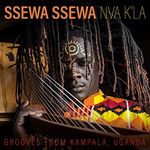 Ssewakiryanga James Jr., known as Ssewa Ssewa, is weaving together the indigenous traditions he grew up with in Kampala
with a modern and global sound. His music is a cross-cultural marriage between Uganda, Africa and the world.
It is about social and global issues, diversity, economic development and empowerment.
"The first step toward success is taken when you refuse to be captive of the environment you find yourself in," says the multi-instrumentalist
reflecting on inventing the Janzi. The Janzi is a musical instrument who has 22 strings on its two long, wooden necks. The 11 strings on the
left-hand neck are tuned in the diatonic scale, and the 11 strings on the right to the pentatonic scale.
Ssewakiryanga James Jr., known as Ssewa Ssewa, is weaving together the indigenous traditions he grew up with in Kampala
with a modern and global sound. His music is a cross-cultural marriage between Uganda, Africa and the world.
It is about social and global issues, diversity, economic development and empowerment.
"The first step toward success is taken when you refuse to be captive of the environment you find yourself in," says the multi-instrumentalist
reflecting on inventing the Janzi. The Janzi is a musical instrument who has 22 strings on its two long, wooden necks. The 11 strings on the
left-hand neck are tuned in the diatonic scale, and the 11 strings on the right to the pentatonic scale.
Ssewa Ssewa "Nva K’la – Grooves from Kampala, Uganda", ARC Music, 2020
Uganda, is now ranked number three (3) in Africa as far as music and entertainment is concerned. Uganda is home to over 65 different ethnic groups and tribes, and they form the basis of all indigenous music. The Baganda, being the most musically vibrant nationality in the country, has defined what constitutes culture and music of Uganda over the last two centuries.
The first form of popular music to arise out of traditional music was the Kadongo Kamu style of music, which arose out of traditional Kiganda music. From the 80's till early 90's, Kadongo Kamu was influenced by musicians such as Peterson Mutebi, Dan Mugula, Sebadduka Toffa, Fred Ssonko, Livingstone Kasozi, Fred Masagazi, Baligidde, Abuman Mukungu, Gerald Mukasa, Sauda Nakakaawa, Matia Luyima, Herman Basudde, and Paulo Kafeero music genres drew from Kadongo Kamu, making it the most influential style of music in Uganda. In the late 90's, Philly Lutaaya, Fred Mbalire and Madoxx Ssematimba also dominated in that period and in early 2000's, a new music genre afro ragga locally called kidandali formed by Bebe Cool and Jose Chameleone and later joined by Bobi Wine as well as Bax-Ragga was formed by Abdu Mulaasi
Currently, because of the effects of globalization, Uganda, like most African countries, has seen a growth in modern audio production. This has led to the adoption of western music styles like Dancehall and Hip Hop.
Traditional Music from different Regions of Uganda
Uganda is divided into 4 regions namely; Central, Northern, Eastern and Western. Each region has distinct traditional music as per the tribes and ethnicities.
The electro-percussion group Nihiloxica was founded in Kampala by two young British musicians and four members of the Nilotika Cultural Ensemble.
The band is exploring the similarities between techno and tradition, between the polyrhythmic drumming from Buganda and
the synthetic sounds of today's dance floor.
Nihiloxica "Kaloli", Crammed Discs, 2020
Uganda's nationalities are diverse and spread evenly throughout the country. Native music in Uganda, like in most African regions, is mainly functional. This means that most music and music activities usually have specific functions related to specific festivities like marriage, initiation, royal festivals, harvests and war among others. The music is performed by skilled tribesmen and women who are good at playing various traditional instruments, folk songs and traditional dances.
Central
The Baganda are found in Buganda in the central region; they are the largest native nationality in the country. The kingdom is ruled by a king, known as a Kabaka. The kabaka has traditionally been the main patron of the music of Buganda. Musical instruments include various forms of drums, making percussion an integral part of the music).
The massive and sacred royal drums are just one of the many drum types. The engalabi is another common drum and it is a long round shaped drum. The drums are used in unison with various other melodic musical instruments ranging from chordophones like the ennanga harp and the entongoli lyre, lamellophones, aerophones, and idiophones and the locally made fiddle called kadingidi.
Music is played for dancing in the community, Call and response style of singing is common with the Bantu from the 19th century. The Baganda have a variety of vibrant dances that go along with the elaborate instrumentation. The bakisimba dance is the most common and most performed. There are others like nankasa and the amaggunju. The amaggunju is an exclusive dance developed in the palace for the Kabaka.
Popular music
Because of Uganda's turbulent political history, there was never enough time for there to be a thriving pop music industry until relative peace was restored in the late 1980s. By then, musicians like Philly Lutaaya, Afrigo Band, and Elly Wamala were the few Ugandan acts to have had mainstream music success. Jimmy Katumba and his music group the Ebonies were also popular at this time, especially towards the 1990s.
Musicians like, Carol Nakimera, Kezia Nambi, Fred Maiso, Kads Band, Rasta Rob, Menton Summer were on top of the Ugandan music game between 1990 and 1997. Artists like, Livingstone Kasozi, Herman Basudde and Paulo Kafeero also played a great role in bringing live music near to the fans.
According to popular music promoter and legendary DJ Erycom, In the year 1998, Uganda experienced the biggest change musically. Thanks to musician Red Banton (the Five star general) who rose to fame with his Noonya Money hit song that played country wide. Red Banton ruled the Ugandan music scene until the year 2000 when Jose Chameleone returned from Kenya with his "Mama Mia" song that turned into a National anthem in Uganda and East Africa at large.
The 1990s saw Uganda's love affair with Jamaican music begin when artists like Shanks Vivi Dee, Ragga Dee, and others were influenced by Jamaican superstars like Shabba Ranks. They imported the Ragga music culture into Uganda and, although they faced stiff competition from other African music styles and musicians at the time, in particular Soukous from Congo and Kwaito from South Africa, they formed the foundation of the pop music industry. But it was not until the 21st century when musicians like Chameleone emerged that a pop music scene really began.
By around 2007, there were a number of musicians practicing varied styles of music, and the role of western and Congolese/South African music had greatly diminished. Today, musicians like Iryn Namubiru and King Saha are just a few of the many pop musicians in a thriving and vibrant pop music scene. The pop music duo of Radio & Weasel, the Goodlyfe Crew, is well known around Africa, being nominated in the continental MTV Base awards in 2010 and BET awards in 2013. In June 2015, Eddy Kenzo won the award for "Best new international artist" at the 2015 BET music awards.
Kadongo Kamu
The word "Kadongo Kamu" is a term in the Luganda language that means "one guitar". The music is given this name because of the role played by the bass guitar, which most times is the solo instrument used in creation of the music. Perhaps the first well known artist of the genre was Fred Masagazi in the 1960s.
The late Elly Wamala contributed a lot in making urban Kadongo Kamu style. Christopher Sebadduka popularised the genre and perhaps this is why he is considered by many to be the God father of kadongo kamu. Elly Wamala abandoned this genre because it was also instrumented by non elite like Christopher Sebadduka. His brand of educative singing won him many fans and he is one of the few musicians who was involved with Uganda's independence in 1962. They were followed by a number of musicians who kept true to the style and sound of the music.
Herman Basudde was a very popular kadongo kamu musician in the 1980s and 1990s. So was Bernard Kabanda. Dan Mugula is one of the few surviving pioneers of the genre. Fred Sebatta and Paulo Kafeero made their mark in the 1990s. Today, the genre is marginalized in favor of more recent styles of music. But because the music is loved by cultural loyalists in the buganda region, it is certain that there will always be an audience for kadongo kamu.
Kidandali
Kidandali is a music genre that currently is arguably the most popular genre of music in Uganda. However, the term "kidandali" is not universally agreed on as the name of this genre with some local sources preferring instead to use the very simplistic term "Band Music" while others prefer the term Afrobeat, even though the music shares no similarities with Afrobeat. The roots of this genre can be traced back to the bands that sprung up after Uganda got independence in 1962.
The Cranes Band, which later gave birth to Afrigo Band, can be regarded as the first group in the evolution process of this genre. At the very outset, their music was heavily influenced by Soukous and congolese artists like Franco were notable influences at the time. Jazz was also a notable influence. Along the way there were other bands like Rwenzori Band, Big Five Band and Simba Ngoma Band. But Afrigo Band was the most prominent and most enduring, especially throughout the political unrest of the 1970s to 1990s.
By the mid 1990s Afrigo Band was still heavily influenced by Soukous music, which by then was dominant all over the African continent. Artists like Joanita Kawalya and Rachael Magoola were part of Afrigo Band and helped lay the foundation for modern day Kidandali, alongside other bands like Kaads Band. The turning point, however, came with the formation of the record label Eagles Production which was responsible for producing artists like Mesach Semakula, Geoffrey Lutaaya, Ronald Mayinja and Haruna Mubiru. These artists took the mantle from Afrigo Band and further developed the genre after the turn of the century.
In the 2000s, the genre became identified with the Eagles Production label. The label continued to produce more talent, especially female artists like Ronald Mayinja, Geoffrey Lutaaya, Mesach Semakula, Roy Kapale, Mariam Ndagire, Phionah Mukasa, Mariam Mulinde, Queen Florence, the late Harriet Kisaakye, Cathy Kusasira, Irene Namatovu and Stecia Mayanja. Another turning point was in 2008 when David Lutalo broke through with the hit song Kapapaala creating the way for the Urban Band genre to move beyond a genre that had for long been dominated by Eagles Production, Diamond Production, Kads Band, Backeys Band, Kats Production, The Hommies among others.
In the year 2003, Uganda witnessed the birth of a new kind on the block, Abdu Mulaasi. With his mega country wide hit "Omusono Gwa Mungu", Abdu Mulaasi became a house hold name creating himself a place amongst the top artists in the country. Abdu Mulaasi went to release hits like: Swimming Pool, Njagal Ebbere, Ekyaapa, Obuffumbo Bwa Liizi, Ngenda Kusiba Farm and Omuchaina. Enkulu Tenywa was another big song that kept Abdu Mulaasi on top of his game. By the end of the year 2010, Abdu Mulaasi had changed the sound of KadongoKamu hence introducing Urban Kadongo Kamu.
DJ Erycom, one of Uganda's legendary Deejays was the first deejay to play, promote and popularize Kadongokamu music across bars and happening places in and outside Uganda.
About the same time, technology in audio production had enabled the genre to be reproduced digitally using Audio Workstations and the "band" element had all but disappeared. Recording studios like Kann, Dream Studios, Mozart and Paddyman took center stage. Many other independent solo artists started to practice the genre. Artists like Dr Tee, Martin Angume and even Chameleone achieved success with this genre. The genre is currently at the peak of its evolution with newer artists like Papa Cidy and Chris Evans helping create a dominant force that, alongside Dancehall, is the most popular stylistic genre in Uganda.
Zimbabwe
Zimbabwean music includes folk and pop styles. Much of the folk music incorporates mbira, Ngoma drums and hosho. Music has played a significant role in the history of Zimbabwe, from a vital role in the traditional Bira ceremony used to call on ancestral spirits, to protest songs during the struggle for independence.
In many cultures, music has the uncanny ability to bring people closer together. For Zimbabwe's Shona community it is what links them to their culture and individual identity. Their way of life was under threat when a large colonialism movement swept through Zimbabwe. This movement forced the Shona people to leave their sacred ancestral lands, the heart of their culture. However, they fought to keep their traditions and ancestors with them through musical representation. Music has the power to influence how people behave. It can evoke certain moods, feelings, and states of mind in people. It is a universal language that can connect people to their past and spread messages.
Mbira
Vusa Mkhaya embodies the sound of the pulsing streets of the Tshabalala township in Zimbabwe’s Bulawayo.
As part of the a cappella trio Insingizi he has gained commercial and critical success.
They ventured from Zimbabwe to Vienna where they discovered a connection to the many musical avenues the city had to offer.
He has since enjoyed fusing these styles with his own music. His third solo album,
UManyanyatha, carries a message of hope and unity: "Hold on, Africa, one day everything is going to
be alright. So many things are said about you. We love you the way you are. One day you will smile. Hold on, my Africa!"

Vusa Mkhaya "UManyanyatha – Songs from the Soul of Zimbabwe", ARC Music, 2020
The mbira is an integral part of Zimbabwean music. Classified by musicologists as a lamellaphone, part of the plucked idiophone family, it is created from things found in nature such as a wooden board (often fitted with a resonator) and tines. It is frequently played in a deze (calabash resonator) which amplifies the sound and augments using shells or bottle caps placed around the edges. Often accompanied by the hosho, a percussion instrument, the mbira is often an important instrument that people play at religious ceremonies, weddings, and other social gatherings. The mbira plays a central role in the traditional Bira ceremony used to call on ancestral spirits.
The instrument is a central piece in their religious rituals. The most important function of mbira is the idea of it being a "telephone to the spirits" during ceremonies. It is the sole way of communication between the living and deceased ancestors, ancient tribal guardians, or guardian spirits. The mbira is required to ask these spirits to bring rain during drought, stop rain during floods, and bring clouds when crops are damaged by the sun. These instruments were made from resources from the land which connected them further connects the indigenous people to their land and this deep connection has helped communities in Zimbabwe to continue their tradition of mbira music despite the development of colonialism.
The sound made by this instrument closely imitates the noises made by rain or running water with rich and vibrant tones "like bells". The sound has a special presence; one that feel the music as much as one hears it. Penetrating and warming at the same time, immediately capturing the involvement of the listeners and drawing them into its mood. The pieces of music played vary by the artist but there is no specific way to play this instrument. The music performed is all about elaboration and variation supporting creative expression of the performer.
Though musicologist Hugh Tracey believed the mbira to be nearing extinction in the 1930s, the instrument has been revived since the 60s and 70s, and has gained an international following through the world music scene. Some renowned mbira players include Dumisani Maraire, Ephat Mujuru, Stella Chiweshe, Chartwell Dutiro, Mbuya Dyoko, Cosmas Magaya, Tute Chigamba, Forward Kwenda, and Chiwoniso Maraire.
There is also pop music in Zimbabwe and around the world that incorporates Zimbabwean indigenous instruments. For example, mbira player Chris Berry with his band Panjea have reached platinum record sales in Zimbabwe and Mozambique, playing a style of music based on traditional mbira rhythms and melodies, but incorporating various other instruments and styles (like hip-hop and dancehall). Mbira is incorporated into the music of critically acclaimed American hip-hop duo Shabazz Palaces by Tendai Maraire (son of traditional mbira player Dumisani Maraire).
Jit
Jit is a generic term for electric guitar-driven pop, and includes popular groups like the New Black Eagles and the Four Brothers (a band UK radio DJ John Peel described as "the best live band in the world"). Internationally, The Bhundu Boys are by far the best-known jit performers, and have worked with numerous American and British musicians. Notable recent bands to come up with the Jit sound are Nehoreka who fuse the traditional Jit with funk sounds, there is also Mokoomba and Q Montana. The 1990 film Jit was named for this style.
Sungura
This is the local genre of the Zimbabwe music industry. Sungura music became popular in the early 1980s, pioneered by frontman Ephraim Joe and his band Sungura Boys which counted many notable future hit makers as members. Their roll included John Chibadura (guitar)
Simon Chimbetu (guitar and vocals) Naison Chimbetu, Ronnie Chataika, Michael Jambo (drums), Ephraim Joe (guitar), Moses Marasha (bass), Never Moyo (lead guitar), Bata Sinfirio (rhythm guitar), System Tazvida (guitar and vocals, Peter Moyo (guitar and vocals).
The Khiama Boys emerged as natural successors to the Sungura Boys after their demise during the mid-eighties. Members would include System Tazvida (Rhythm guitar), Nicholas Zacharia (Lead guitar), Alick Macheso (Bass), Silas Chakanyuka (Drums) and Zacharia Zakaria (Sub Rhythm guitar). A great number of these artistes have gone on to forge successful careers with their own bands whilst Nicholas Zacharia has remained as the leader of the band and is still active as of 2008.
James Chimombe, whose romantic ballads and the influential sungura guitar melody (consisting of lead, rhythm and bass), made him a favorite in the late 80s.
The 90s was dominated by musicians include Leonard Dembo, the effervescent Khiama Boys, veteran Simon Chimbetu and upcoming artistes Alick Macheso, Tongai Moyo and Somadhla Ndebele. The star of the decade was Leonard Zhakata, whose musical project was a spinoff of the double play Maungwe Brothers, an act fronted by Zhakata and his cousin Thomas Makion. The decade 2000 till present has been characterised by a wrangle for the crown for the kingship of Sungura between the two most Sungura musicians of the decade, Alick Macheso and Tongai Moyo. Having dominated sales, tour and concert attendances, the heckling and counter-heckling by the artists at shows and in some recorded material is strong proof that the current feud is far from over.
Other artists to come through this decade include Joseph Garakara, Gift Amuli, Howard Pinjisi and Daiton Somanje. And of late, Alick Macheso has become popular with his dance zoraaa butter.
System Tazvida, Simon Chimbetu, John Chibadura, Leonard Dembo, and Thomas Makion have all died.
Afro Jazz is a term used for Zimbabwean music influenced by a style of township rhythm that evolved in a Southern part of Africa over the last century. One can also trace similarities from Kwela, a pennywhistle-based, street music from the southern part of Africa with jazzy underpinnings and a distinctive, skiffle-like beat. It is also closely related to Marabi which was the name given to a keyboard style (often using cheap pedal organs) that had a musical link to American jazz, ragtime and blues, with roots deep in the African tradition. Early marabi musicians were part of an underground musical culture and were typically not recorded. An example of such an artist in the early 1940s is August Musarurwa of the Skokiaan fame. It has continued to develop and you can even see traits of this music in his grandson Prince Kudakwashe Musarurwa.
Chimurenga music
Chimurenga music is a genre developed by Thomas Mapfumo named for the Shona language word for struggle. Mapfumo and his band, the Blacks Unlimited developed a style of music based on traditional mbira music, but played with modern electric instrumentation, with lyrics characterized by social and political commentary. Mapfumo's music was a "tool of the liberation war" criticizing the Rhodesian government of Ian Smith, but shifted after independence to speaking out about perceived corruption and mismanagement of the Zimbabwean government of Robert Mugabe.
Tuku Music
Oliver "Tuku" Mtukudzi was a prolific recorder who also appeared in films like Jit. He played in a plethora of styles, and was known for penetrating lyrics; for example, he wrote a second song about AIDS in Zimbabwe after Paul Matavire's hit song "Yakauya AIDS iriko".
Zimdancehall is a term used for Zimbabwean music influenced by Jamaican Dancehall music. A lot of debate is around the question of who started Zimdancehall in the country. Notable names in the genre are Souja Luv, Killer T, Enzo Ishall, Jah Signal, Winky D, Ras Caleb, Kinna, Chillspot records, Seh Calaz, freeman, Boss Pumacol, Uncle Epaton.
Gospel
Gospel music became popular in Zimbabwe in the late 1980s. Jonathan Wutawunashe has been described as "Zimbabwe's first real gospel star". Other population musicians in this genre include Jordan Chataika, Freedom Sengwayo, Mechanic Manyeruke, and Brian Sibalo.
The early nineties saw the rising of new gospel stars in the mold of Ivy Kombo - Moyo and Carol Mujokoro of the EGEA gospel Train whose debut album Mufudzi Wangu was released in 1993 and contains tracks such as "Be Thou My Vision", "Ndotarisa Kumakomo" and "Utiziro" among others. The two went on to pursue successful solo musical careers and released "Ndaidziwanepi Nyasha" and "Ropa RaJesu" as their debut solo albums respectively.
Gospel artists who emerged from the mid nineties include Lawrence Haisa, Brother Sam with his hits "Makanaka Jesu" and "Cherechedza", Elias Musakwa, Rita Shonhiwa, The Gospel Trumpet of the "Rose Of Sharon" fame and Shingisai Suluma who only became popular in the early 21st century with the hit song "Mirira Mangwanani"; though she first recorded in the nineties.
In the late-nineties, Charles Charamba, a rising artist, grew in popularity, and currently holds gospel sales records. His music became popular into the first decade of the 21st century, most likely due to his Sungura-based contemporary style.
In the early 21st century, a lot of gospel artists also recorded, though a few really rose to stardom. These include Fungisai Zvakavapano - Mashavave who has risen to become the most dominant female gospel musician in the current era, Stanley Gwanzura (Pastor Gee), Kudzai Nyakudya and gospel a cappella outfits like Vabati VaJehovah and Shower Power.
Bulawayo
The Ndebele-dominated region of the southwest of Zimbabwe, including the city Bulawayo, has been instrumental in the development of Zimbabwean music. Seminal 1950s guitarist George Sibanda had a following across Africa and was the writer for the hit song Guabi Guabi which is sang all over the world, and Dorothy Masuka was a major player on the South African jazz scene, for example. Among the most popular performers of the region within Zimbabwe, however, was 1980s Ndebele pop sensation Lovemore Majaivana. Ndebele musicians who are active are Black Umfolosi, Insingizi, Majahawodwa Ndlovu, Sandra Ndebele, Lwazi Tshabangu, Kuxxman, Go Boyz, Achuzi, Beate Mangethe, Vusa Mkhaya, Afrika Revenge and Ramadu. The marginalisation of Bulawayo artists in Zimbabwe saw the influence of South African music dominating hence the emergence of kwaito music in Bulawayo pioneered by Go-Boyz in 1996 and more groups like GTI, Achuzi, Amagangsters, etc., emerged. A brand of Jazz was created in Bulawayo, in the 1940s and 1950s, and was made popular by August Musarurwa with his African Dance Band of the Cold Storage Commission of Southern Rhodesia. He recorded the legendary song Sikokiana which went on to be recorded in USA by Louis Armstrong and many others.
Lyrics
Zimbabwean musicians' lyrics mostly contain encouragement of upholding good social values in the family and society as whole. Such lyrics can be seen in songs by artists like Oliver Mtukudzi, Simon Chimbetu, Nehoreka Louis Mhlanga, John Chibadura, Steve Makoni, Bhundu Boys and many others. Of note however is Thomas Mapfumo, whose lyrics are mainly political and encourage good leadership and rising against bad governance - Most of his albums are named after a word meaning Uprising or War of Liberation, "Chimurenga". His music has earned him the wrath of the ZANU-PF government resulting in the banning of most of his music on state owned radio and TV. Another outstanding musician with striking lyrics is the late System Tazvida of the Chazezesa Challengers. His lyrics were mainly centered on the subject of "Love" and this gained him popularity with songs like "Anodyiwa Haataure", "Ukarambwa Usachema", "Vanotipedzera Mashoko" and "Dai Hanzvadzi Yairoorwa".
With the coming of "Urban Grooves" the lyrics content resembles that of American RnB, Hip Hop and Pop music which the younger generations listen to. One artist Maskiri is known for imitating Eminem's style of controversial lyrics.

From Wikipedia, the free encyclopedia
[en.wikipedia.org/wiki/Music_of_Benin,
en.wikipedia.org/wiki/Music_of_Ghana,
en.wikipedia.org/wiki/Music_of_Uganda,
en.wikipedia.org/wiki/Music_of_Zimbabwe].
Wikipedia® is a registered trademark of the Wikimedia Foundation, Inc., a non-profit organization.
Text is available under the Creative Commons Attribution-ShareAlike License.
Date: October 2020.
Photo Credits:
(1) "The Rough Guide to African Beats",
(2)-(3) Star Femine Band,
(4) Angelique Kidjo,
(5) Helsinki-Cotonou Ensemble,
(6)-(7) Y-Bayani & Baby Naa,
(8) Osei Kwame Korankye,
(9) Wiyaala,
(10) Adjiri Odametey,
(11)-(12) Ssewa Ssewa,
(13)-(14) Nihiloxica,
(15) Geoffrey Oryema,
(16)-(17) Vusa Mkhaya,
(18) Mbira,
(19) Thomas Mapfumo,
(20) Hope Masike (Monoswezi),
(21) Mokoomba
(unknown/website);
(22) Hans Theessink & Insingizi
(by Walkin' Tom).
FolkWorld - Home of European Music
 Layout & Idea of FolkWorld © The Mollis - Editors of FolkWorld
Layout & Idea of FolkWorld © The Mollis - Editors of FolkWorld